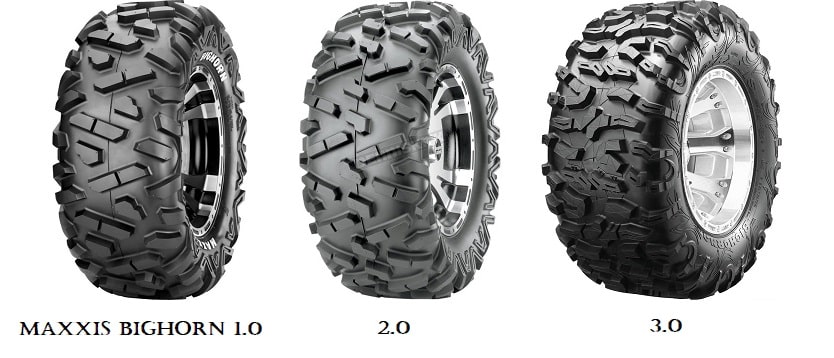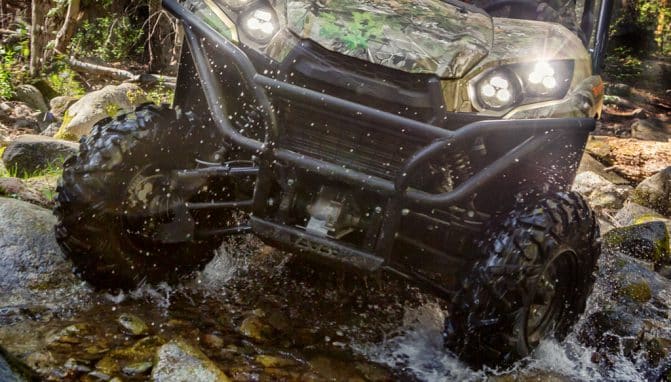Maxxis Bighorn Review for 2024
Provided you’re an ATV driver, you’d already be aware that these vehicles need certain modifications to protect your ride from the damage and rigors of off-road conditions. However, since additional protective gear adds pounds to the ATV’s weight, it might end up impacting its handling and performance.
What you need, therefore, is an upgrade that provides you the best of both worlds. That means that where on one end it should enhance the sturdiness and damage-limiting ability of your vehicle, the protective gear shouldn’t tip the scales of the weight machine, on the other.
Perhaps that’s the reason why some UTV drivers go for the Maxxis Bighorn Radial Tire. Designed for use on a wide range of 4x4s, jeeps, pickups, and SUVs, it’s a rugged MT tire which gives the traction your vehicle needs when driving through sand, gravel, mud, and other difficult off-road terrains.
Keep on reading to see how the Maxxis Bighorn fared in our review.
List of Maxxis Tires Review
Maxxis Bighorn Review: Features
Even for a radial construction tire, the Maxxis Bighorn has a wide footprint providing excellent traction and better shock absorption. That’s what its manufacturer claims. To gauge the veracity behind this statement, let’s look at its features before we take this tire on a test ride.

Available in three versions
The fame enjoyed by the original Bighorn allowed Maxxis to churn out three versions of this tire to fully cash in on its popularity. Here’s how all three versions differ from each other.
- Maxxis Bighorn 1.0: Available in 12-, 14-, and 15-inch rim sizes, this tire comes in both rear and front versions. It’s a 6-ply radial tire and has staggered shoulder lugs, a wider footprint and pinning for studs to boost all-terrain utility.
- Maxxis Bighorn 2.0: Similar to the original Bighorn, the 2.0 is a 6-ply tire, comes in rear and front models, and fits 12-inch and 14-inch rim sizes. However, since its tread bars are relatively slimmer, this tire is lighter than its predecessor.
- Maxxis Bighorn 3.0: In contrast to the two versions that came before it, the Maxxis Bighorn 3.0 doesn’t have a non-directional tread pattern on both its front and rear tires. Rather, its front version breaks away from tradition by offering a directional pattern.

Staggered Shoulder Lugs
If you’ve only recently started embarking on off-road expeditions, you might not be aware of the importance of staggered shoulder lugs – one of the many aspects of a mud-terrain tire which takes it poles apart from an all-terrain tire.
Thanks to large shoulder lugs, the Maxxis Bighorn is capable of providing added traction in uneven terrains. They do that by expanding the surface area of the tire which comes into contact with the road. As that happens, the tire can grip the road better, thereby protecting the tire’s sidewalls.
Deep tread blocks
Once you start off-roading, you’ll become aware that it isn’t only the rigors of difficult terrains that might shorten the shelf life of your tire. Instead, the sticky mud particles which have the tendency to get glued on the inside of tire have the potential to do as much damage.
To keep such particles away, Maxxis has provided the Bighorn with deep tread blocks. These parts offer self-cleaning capabilities by forcing out mud particles from within the tire’s terrain. As a result, you won’t see the Bighorn experiencing uneven wear.

Pinned for studs
In contrast to what most people might choose to believe, not every all-terrain tire can prove its utility on snowy roads. That is, because, in contrast to other terrains, snow-laden roads are exceedingly slippery. What they need from a tire to give it traction in return is something extra.
Fortunately, the Maxxis Bighorn provides that something extra in the shape of its pining for studs. These are small openings alongside the tire’s circumference where you can insert studs (sold separately). The studs, in turn, will provide the tire traction on snowy surfaces.
Maxxis Bighorn Review: Test Drive
If you or a friend of yours has recently bought a UTV, you might have noticed the presence of the Bighorn as a stock tire. This tire has won championships and races across multiple formats of the game and has gained legendary fame. Is its popularity justified? To answer this question, let’s take the Maxxis Bighorn on a test-ride.
Treadwear and Durability
Although the front tire of the Bighorn 3.0 has decided to do away with it, one of the biggest reasons for the success of this tire is its non-directional tread pattern. Apart from having enough space to self-clean mud, this pattern features a wrap-around on its sidewalls to give extra traction in rocks and nuts, too.
Furthermore, since this tire’s profile is semi-flat, the Bighorn can afford to have a wide footprint. Its sidewall tread resists punctures and the rubber compound wears slowly. Mix everything we just stated, and what you get is a tire that promotes even treadwear.
As for its durability, that’s where you’d thank Maxxis for using six-ply construction. Even though the engineers at Maxxis have thinned out the legs in the latest version of the Bighorn, the protection on offer by the six-ply construction – both to the sidewall and tread – makes this tire ultra-durable.
Mud and Rocky terrain
In case you weren’t convinced earlier, the non-directional tread pattern of the Bighorn will make you aware of its importance on mud and rocky terrains. By making the overall profile of the tire semi-flat, it provides the Bighorn with a large footprint.
That, in turn, allows the tire to provide more-than-decent traction on rocks, desert, and most dirt situations. Also, since the sidewalls have an extra wrap-around tread, they too are responsible for providing extra traction in rocks and ruts.
Self-cleaning is another area where this model shines. After an hour or two of riding it through the mud, you won’t be able to find large mud deposits in its tread. That is, because, it contains deep-tread blocks that self-clean the tire to remove stubborn mud particles.
Wet and Snowy terrain
To be honest with you, we didn’t expect this tire to perform as well as it did on snowy terrains. It surprised us by not showing any signs of slippage for the major part of our test ride in wet weather conditions. On further inspection, we were able to determine the causes.
First, in contrast to your average summer and all-season tires, the Bighorn doesn’t feature a stiffer rubber compound – which expands when the tire’s rolling on hot pavement. It contains a soft rubber compound which remains pliable in winter conditions and offers better traction on ice and snow.
Yet another reason is its tread design. It has a higher ‘’void-to-lug’’ ratio, meaning the tread’s blocks feature larger grooves between them. Add to the equation its sharp and irregular edges, and the Bighorn cuts into the snow before capturing some of it into the voids to allow its tread to maintain close contact with the road and provide even traction.
Comfort and Noise
One of the reasons why Maxxis chose Radial construction for this tire is to make your ride as comfortable as possible. That’s because tires that have this construction have a flexible sidewall that protects the interior and projects a comfortable ride.
Similarly, due to the extra space on offer, the Bighorn can afford to have a ply cord which withstands road shocks and load well. Maxxis has also equipped this tire with a thick shoulder to absorb off-road vibrations and make your riding experience a comfortable one.
The opposite is true for noise. With its aggressive tread pattern, this tire generates more-than-a-little noise, especially when you’re slowing down the vehicle or just starting from a stationary position. It means that you shouldn’t expect it to be quiet.
Performance on dry pavement
Using an all-terrain tire like the Bighorn on dry tarmac is like taking Michael Jordan to your local NBA game. It’s overkill. Why should anyone pay the extra dollars that this model demands for its all-terrain utility and then end up using it on fully paved terrains? Of course, you can do that if you may wish.
Maxxis Bighorn Review: Conclusion
The Maxxis Bighorn is one of those tires which are at home on all types of difficult terrains. Provided you want a tire for use on construction sites, gravel roads, farms and other terrains where traction and durability are required, any of the three versions of this tire might be worth a shot.
Pros
- Provides excellent traction on difficult terrains
- Excellent grip on snow and ice
- Offers good value for money
Cons
- Noisy

